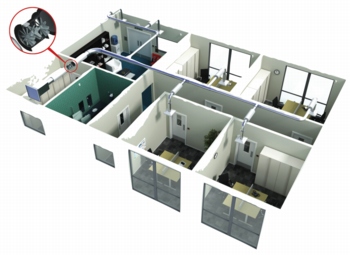Energy-efficient ventilation

Alan Macklin argues that because buildings are serviced for the benefit of people in them, there major opportunities for saving energy by controlling services such as ventilation according to occupancy.
Nobody involved in the design and construction of buildings, whatever their role in the process, can be unaware of the ever increasing importance of energy efficiency. An estimated 40% of the world’s energy is consumed by buildings. So finding ways in which our buildings can become greener is key.
In 2001 the European Council adopted ambitious energy and climate change objectives for 2020.
• Reduce greenhouse gas emissions by 20%, rising to 30% if the conditions are right.
• Increase the share of renewable energy to 20%.
• Make a 20% improvement in energy efficiency.
In terms of the HEVAC sector, implementation of the European Union energy objectives is legislated by the Energy Performance of Buildings Directive (EPBD) and the Energy-related Products Directive (ErP).
The EPBD is applicable to fan systems through Parts F and L of the Building Regulations, which specifies minimum ventilation rates and specific fan powers.
The ErP Directive is applicable to fans and electric motors through the specification of minimum IE2 efficiency levels for single-speed 3-phase motors from 16 June 2011 and the introduction of mandatory minimum Fan Motor Efficiency Grade (FMEG) fan efficiency values from 1 January 2013.
Occupancy is one of the most significant factors in managing energy efficiently. Why do we automate a building? Why do we make a building comfortable? Why do we supply energy into a building? It is for the people within that building — so ultimately it is occupancy that drives everything. It is an obvious statement to make, but one that is the fundamental starting point for managing HVAC that an empty building does not have the HVAC requirements of a full building.
Despite the simplicity of the concept, it is surprising how many ventilation systems operate at constant or pre-determined ventilation rates, regardless of the occupancy levels. Ventilation rates are normally based on maximum occupancy levels. In many buildings, from airports to retail outlets, there are massive variations in numbers present, so a system set to accommodate maximum numbers can result in significant wasted energy. This is not only due to the fan operation, but also to the energy employed in conditioning the air — whether in heating or cooling mode.

Demand-controlled ventilation (DCV) is recognised as a method of ensuring a building is ventilated cost effectively while maximising indoor air quality. With people spending an estimated 90% of their time indoors, effective ventilation is vital to prevent adverse health consequences, particularly in modern buildings which are becoming increasingly airtight to help meet the ever-more demanding energy-efficiency targets alluded to earlier. A number of factors affect air quality, from volatile organic compounds created by aerosols and modern materials to mould spores from dust and dust mites.
In DCV, closed-loop speed control for EC and AC motors provides major energy savings as the fan power is proportional to the cube of its speed. Sensors are used to continuously measure and monitor ambient conditions in the conditioned space and provide real-time feedback to the zone controller, which adjusts the fan speed to match the ventilation rate to the specific use and occupancy of the building. Significant energy savings are made by effective DCV to ensure that the ventilation rate continuously matches the current occupancy rate and varying ambient conditions.
Another important factor in achieving efficiency in an HVAC application is the design of the system itself. An efficient fan and controls will not provide the desired savings if installed in a poorly designed system.
The equation for specific fan power can be rewritten as follows.
SFP = fan pressure/overall efficiency, including controls
It is clear that reducing the system resistance will proportionately reduce the specific fan power.
DCV will provide a short payback with a simple justification if the lifecycle costs (total cost of ownership over the life of the product, including the running costs) are considered. Similar approaches are adopted in areas such as heating and lighting, recognising that using appropriate sensor technology enables an intelligent approach to be taken to energy consumption — bringing supply in line with demand.
Of the estimated 40% of the world’s energy that is consumed by buildings, some 85% is used for room heating or cooling. It is therefore readily apparent that this is an area where any contribution to improving energy management can have a significant impact. A combination of high fan efficiency, an effective control system and good system design will result in energy-efficient ventilation and lower the operational costs of the building while maintaining good indoor air quality.
Alan Macklin is group technical manager at Elta Group







